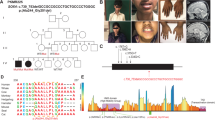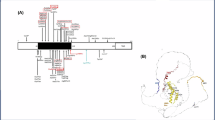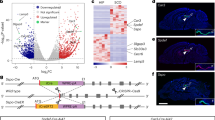Abstract
The pituitary develops from the interaction of the infundibulum, a region of the ventral diencephalon, and Rathke's pouch, a derivative of oral ectoderm. Postnatally, its secretory functions are controlled by hypothalamic neurons, which also derive from the ventral diencephalon. In humans, mutations affecting the X-linked transcription factor SOX3 are associated with hypopituitarism and mental retardation, but nothing is known of their etiology. We find that deletion of Sox3 in mice leads to defects of pituitary function and of specific central nervous system (CNS) midline structures. Cells in the ventral diencephalon, where Sox3 is usually highly expressed, have altered properties in mutant embryos, leading to abnormal development of Rathke's pouch, which does not express the gene. Pituitary and hypothalamic defects persist postnatally, and SOX3 may also function in a subset of hypothalamic neurons. This study shows how sensitive the pituitary is to subtle developmental defects and how one gene can act at several levels in the hypothalamic-pituitary axis.
This is a preview of subscription content, access via your institution
Access options
Subscribe to this journal
Receive 12 print issues and online access
$259.00 per year
only $21.58 per issue
Buy this article
- Purchase on SpringerLink
- Instant access to full article PDF
Prices may be subject to local taxes which are calculated during checkout








Similar content being viewed by others
References
Dasen, J.S. & Rosenfeld, M.G. Signaling and transcriptional mechanisms in pituitary development. Annu. Rev. Neurosci. 24, 327–355 (2001).
Kimura, S. et al. The T/ebp null mouse: thyroid-specific enhancer-binding protein is essential for the organogenesis of the thyroid, lung, ventral forebrain, and pituitary. Genes Dev. 10, 60–69 (1996).
Ericson, J., Norlin, S., Jessell, T.M. & Edlund, T. Integrated FGF and BMP signaling controls the progression of progenitor cell differentiation and the emergence of pattern in the embryonic anterior pituitary. Development 125, 1005–1015 (1998).
Treier, M. et al. Multistep signaling requirements for pituitary organogenesis in vivo. Genes Dev. 12, 1691–1704 (1998).
Schepers, G.E., Teasdale, R.D. & Koopman, P. Twenty pairs of sox: extent, homology, and nomenclature of the mouse and human sox transcription factor gene families. Dev. Cell 3, 167–170 (2002).
Laumonnier, F. et al. Transcription factor SOX3 is involved in X-linked mental retardation with growth hormone deficiency. Am. J. Hum. Genet. 71, 1450–1455 (2002).
Stevanovic, M., Lovell-Badge, R., Collignon, J. & Goodfellow, P.N. SOX3 is an X-linked gene related to SRY. Hum. Mol. Genet. 2, 2013–2018 (1993).
Zucchi, I. et al. Transcription map of Xq27: candidates for several X-linked diseases. Genomics 57, 209–218 (1999).
Collignon, J. Study of a new family of genes related to the mammalian testis determining gene. (University of London, 1992).
Foster, J.W. & Graves, J.A. An SRY-related sequence on the marsupial X chromosome: implications for the evolution of the mammalian testis-determining gene. Proc. Natl. Acad. Sci. USA 91, 1927–1931 (1994).
Collignon, J. et al. A comparison of the properties of Sox-3 with Sry and two related genes, Sox-1 and Sox-2. Development 122, 509–520 (1996).
Wood, H.B. & Episkopou, V. Comparative expression of the mouse Sox1, Sox2 and Sox3 genes from pre-gastrulation to early somite stages. Mech. Dev. 86, 197–201 (1999).
Uchikawa, M., Kamachi, Y. & Kondoh, H. Two distinct subgroups of Group B Sox genes for transcriptional activators and repressors: their expression during embryonic organogenesis of the chicken. Mech. Dev. 84, 103–120 (1999).
Zernicka-Goetz, M. & Pines, J. Use of Green Fluorescent Protein in mouse embryos. Methods 24, 55–60 (2001).
Lewandoski, M., Meyers, E.N. & Martin, G.R. Analysis of Fgf8 gene function in vertebrate development. Cold Spring Harb. Symp. Quant. Biol. 62, 159–168 (1997).
Graves, J. Interactions between SRY and SOX genes in mammalian sex determination. BioEssays 20, 264–269 (1998).
Kendall, S.K., Samuelson, L.C., Saunders, T.L., Wood, R.I. & Camper, S.A. Targeted disruption of the pituitary glycoprotein hormone alpha-subunit produces hypogonadal and hypothyroid mice. Genes Dev. 9, 2007–2019 (1995).
McGuinness, L. et al. Autosomal dominant growth hormone deficiency disrupts secretory vesicles in vitro and in vivo in transgenic mice. Endocrinology 144, 720–731 (2003).
Thor, S., Ericson, J., Brannstrom, T. & Edlund, T. The homeodomain LIM protein Isl-1 is expressed in subsets of neurons and endocrine cells in the adult rat. Neuron 7, 881–889 (1991).
Avner, P. & Heard, E. X-chromosome inactivation: counting, choice and initiation. Nat. Rev. Genet. 2, 59–67 (2001).
Shibusawa, N. et al. Requirement of thyrotropin-releasing hormone for the postnatal functions of pituitary thyrotrophs: ontogeny study of congenital tertiary hypothyroidism in mice. Mol. Endocrinol. 14, 137–146 (2000).
Lin, S.C. et al. Molecular basis of the little mouse phenotype and implications for cell type-specific growth. Nature 364, 208–213 (1993).
Dattani, M.T. et al. Mutations in the homeobox gene HESX1/Hesx1 associated with septo-optic dysplasia in human and mouse. Nat. Genet. 19, 125–133 (1998).
Weiss, J. et al. Sox3 is required for gonadal function, but not sex determination, in males and females. Mol. Cell. Biol. 23, 8084–8091 (2003).
Overton, P.M., Meadows, L.A., Urban, J. & Russell, S. Evidence for differential and redundant function of the Sox genes Dichaete and SoxN during CNS development in Drosophila. Development 129, 4219–4228 (2002).
Uwanogho, D. et al. Embryonic expression of the chicken Sox2, Sox3 and Sox11 genes suggests an interactive role in neuronal development. Mech. Dev. 49, 23–36 (1995).
Mayo, K.E. et al. Regulation of the pituitary somatotroph cell by GHRH and its receptor. Recent Prog. Horm. Res. 55, 237–67 (2000).
Solomon, N.M. et al. Increased gene dosage at Xq26-q27 is associated with X-linked hypopituitarism. Genomics 79, 553–559 (2002).
Lindsay, R., Feldkamp, M., Harris, D., Robertson, J. & Rallison, M. Utah Growth Study: growth standards and the prevalence of growth hormone deficiency. J. Pediatr. 125, 29–35 (1994).
Dymecki, S.M. Flp recombinase promotes site-specific DNA recombination in embryonic stem cells and transgenic mice. Proc. Natl. Acad. Sci. USA 93, 6191–6196 (1996).
McMahon, A.P. & Bradley, A. The Wnt-1 (int-1) proto-oncogene is required for development of a large region of the mouse brain. Cell 62, 1073–1085 (1990).
Kaufman, M.H. The Atlas of Mouse Development. (Academic, London, 1994).
Avilion, A.A., Bell, D.M. & Lovell-Badge, R. Micro-capillary tube in situ hybridisation: a novel method for processing small individual samples. Genesis 27, 76–80 (2000).
Dunwoodie, S.L., Henrique, D., Harrison, S.M. & Beddington, R.S. Mouse Dll3: a novel divergent Delta gene which may complement the function of other Delta homologues during early pattern formation in the mouse embryo. Development 124, 3065–3076 (1997).
Parsons, M. A functional analysis of Sox3, an X-linked Sry related gene. (University of London, 1997).
Jones, C.M., Lyons, K.M. & Hogan, B.L. Expression of TGF-beta-related genes during mouse embryo whisker morphogenesis. Ann. NY Acad. Sci. 642, 339–345 (1991).
Martinez-Barbera, J.P. et al. Regionalisation of anterior neuroectoderm and its competence in responding to forebrain and midbrain inducing activities depend on mutual antagonism between OTX2 and GBX2. Development 128, 4789–4800 (2001).
Li, M., Pevny, L., Lovell-Badge, R. & Smith, A. Generation of purified neural precursors from embryonic stem cells by lineage selection. Curr. Biol. 8, 971–974 (1998).
Flavell, D.M. et al. Dominant dwarfism in transgenic rats by targeting human growth hormone (GH) expression to hypothalamic GH-releasing factor neurons. EMBO J. 15, 3871–3879 (1996).
Snedecor, G. & Cochran, W. Statistical Methods. (1967).
Acknowledgements
We thank I. Harragan and W. Hatton for assistance with histology, J. Turner and P. Burgoyne for sharing their expertise in gonadal phenotypes, D. Whittcut and P. Mealyer for taking good care of the mouse colony, L. Dubois and J.-P. Vincent for critical reading of the manuscript and C. Wise and other members of the laboratory for their help and encouragement. This work was supported by the MRC, by a European Union Network Grant and the Louis Jeantet Foundation and by Marie Curie Postdoctoral Fellowships to K.R. and S.B.
Author information
Authors and Affiliations
Corresponding author
Ethics declarations
Competing interests
The authors declare no competing financial interests.
Supplementary information
Rights and permissions
About this article
Cite this article
Rizzoti, K., Brunelli, S., Carmignac, D. et al. SOX3 is required during the formation of the hypothalamo-pituitary axis. Nat Genet 36, 247–255 (2004). https://doi.org/10.1038/ng1309
Received:
Accepted:
Published:
Issue date:
DOI: https://doi.org/10.1038/ng1309
This article is cited by
-
The presence and distribution of various genes in postnatal CLP-affected palatine tissue
Maxillofacial Plastic and Reconstructive Surgery (2024)
-
Eighty million years of rapid evolution of the primate Y chromosome
Nature Ecology & Evolution (2023)
-
Xq26.3-q27.1 duplication including SOX3 gene in a Chinese boy with hypopituitarism: case report and two years treatment follow up
BMC Medical Genomics (2022)
-
Identification of an SRY-negative 46,XX infertility male with a heterozygous deletion downstream of SOX3 gene
Molecular Cytogenetics (2022)
-
Insights into non-classic and emerging causes of hypopituitarism
Nature Reviews Endocrinology (2021)



